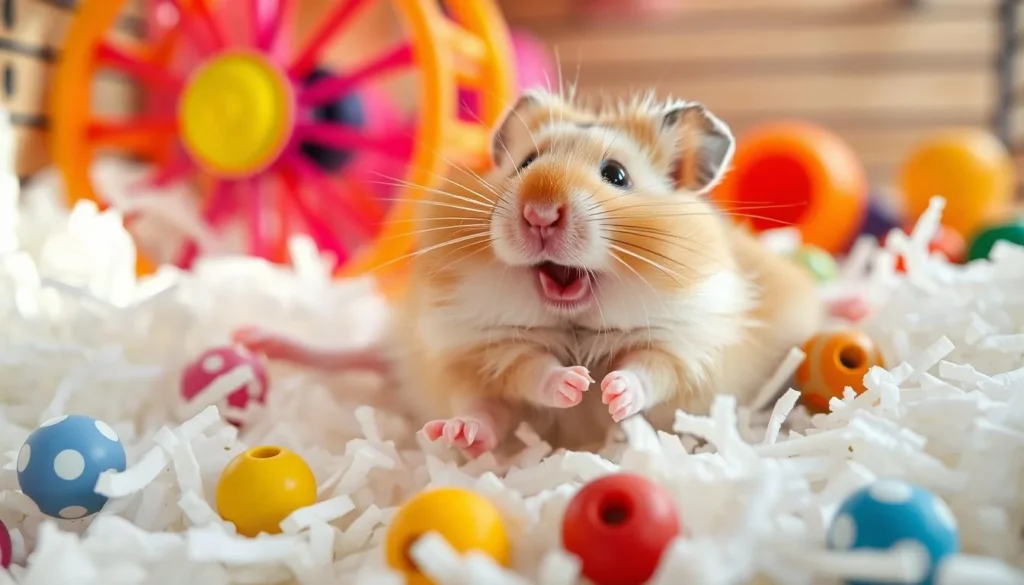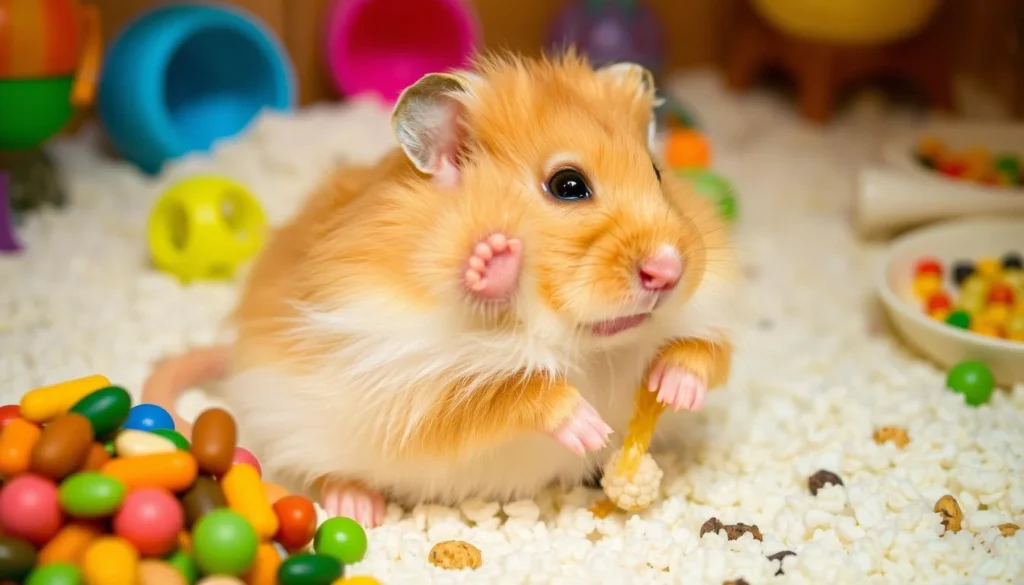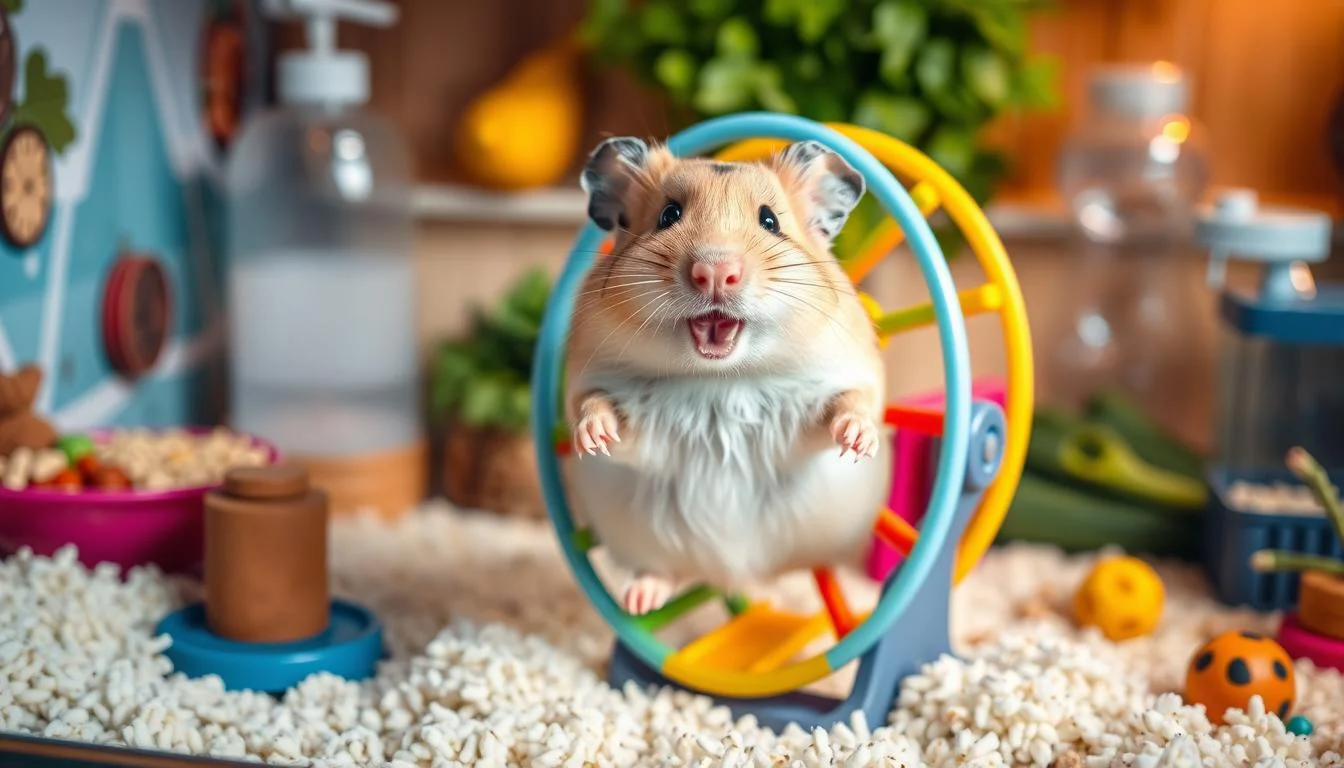Table of Contents
Getting a hamster is like welcoming a tiny bundle of joy. These small creatures have big personalities and emotional needs. Knowing your hamster’s happy signs can make your bond stronger.
Hamsters talk a lot through their actions. It’s not just fun—it’s about keeping them happy and healthy. Their nighttime play and body language show if they’re doing well.
Key Takeaways
- Learn to recognize subtle signs of hamster happiness
- Understand the importance of observing your pet’s behavior
- Identify possible health issues through behavior
- Create an environment that supports their natural instincts
- Develop a stronger bond through attentive care
Understanding Normal Hamster Behavior
Exploring the world of hamsters is truly captivating. They have unique behaviors and body language that might seem strange at first. But, knowing their natural ways can make you a better hamster owner.

Natural Instincts and Daily Patterns
Hamsters are nocturnal, meaning they are most active at night. Their body language tells a lot about their mood and health. Here are some key behaviors:
- Hoarding food in hidden pouches (derived from the German word hamstern, meaning “to hoard”)
- Running miles on their wheel during nighttime hours
- Burrowing and creating complex underground tunnels
Interpreting Hamster Body Language
To spot when your hamster is happy, you need to watch closely. Look for these signs:
- Relaxed, forward-facing ears
- Smooth, clean fur
- Active exploration during nighttime
- Comfortable stretching and grooming
Nocturnal Activity Cycles
Hamsters are naturally most active at night. They start their busy time around sundown. They run, explore, and do lots of things. During the day, they usually sleep.
Understanding your hamster’s natural behaviors helps create a supportive, enriching environment for these fascinating little companions.
Physical Appearance of a Healthy Hamster

A hamster’s look tells a lot about their health. A lively hamster shows signs of being well and content. These signs are easy to spot.
There are key signs of a happy hamster you can see:
- Bright, clear eyes without discharge
- Clean, soft fur without bald patches
- Ears free from crusts or unusual discharge
- Evenly aligned teeth with a yellow-orange color
Eye health is very important. A healthy hamster’s eyes should be:
- Clear and alert
- Free from redness
- Without watery or colored discharge
Coat condition is another vital indicator of your hamster’s well-being. A healthy coat is clean, soft, and shiny. But, too much hair loss could mean health problems.
“A hamster’s physical appearance is a window into their overall health and happiness.” – Veterinary Hamster Experts
Watch for small changes. Regular vet visits can catch about 70% of health issues early. This keeps your hamster healthy and happy.
Happy Hamster Signs: Movement and Activity
Knowing how your hamster moves can tell you a lot about their happiness. Active hamsters show joy through their lively actions and eager to explore.
Proper Exercise Patterns
Hamsters are full of energy and need to stay active. They can run up to 5 miles in a single night on a good wheel. Giving them the right place to exercise keeps them both physically and mentally healthy.
- Regular wheel usage indicates a healthy, happy hamster
- Minimum of 30 minutes of active movement recommended nightly
- Varied exercise equipment prevents boredom
Wheel Usage Frequency
An exercise wheel is essential for your hamster. They have an instinct to run, and a good wheel lets them do just that.
“A happy hamster is an active hamster”
Exploration Behaviors
Hamsters that are curious and adventurous show their joy by exploring. Look out for these signs:
- Climbing and investigating cage accessories
- Burrowing through bedding materials
- Investigating new toys with enthusiasm
By understanding and supporting your hamster’s natural movement, you’ll have a lively and healthy friend.
Eating and Drinking Habits
It’s important to know how your hamster eats and drinks to spot happy signs. A happy hamster shows it through what they eat and how they act at mealtime.
A good diet for a hamster should have:
- High-quality commercial rodent pellets
- Small amounts of fresh vegetables
- Limited fruit treats
- Fresh, clean water daily
Look for these signs that your hamster is happy:
- They love to eat
- They eat at regular times
- They keep a healthy weight
- They chew their food well
“A well-fed hamster is a happy hamster!” – Veterinary Nutritionists
Watch how much your hamster drinks. If they drink a lot and have bright eyes, they’re likely healthy. Dehydration can quickly harm a hamster’s health, so make sure they always have fresh water.
Hamsters love to forage. Try making their meals fun by hiding food in their bedding or using puzzle feeders.
Social Interactions and Temperament
Understanding your hamster’s social behavior is key to building a strong bond and recognizing their happiness. These small creatures have unique ways of communicating their comfort and trust with their owners.
Response to Handling
Hamster behavior cues during handling reveal much about their emotional state. When your hamster feels comfortable, they will:
- Remain calm when gently picked up
- Sit quietly in your hand without attempting to escape
- Show curiosity by exploring your palm
- Maintain relaxed body posture
Bonding Behaviors
Hamster happiness indicators include specific interactions that show they trust you. Look for signs such as:
- Approaching you when you near their cage
- Taking treats directly from your hand
- Allowing gentle head scratches
- Minimal defensive reactions like biting or squeaking
“A well-socialized hamster is a happy hamster.” – Veterinary Hamster Experts
Stress-Free Signs
Recognizing when your hamster feels safe is key. Stress-free hamsters show relaxed behaviors like smooth movements. They also have regular eating patterns and consistent grooming routines.
With patient handling and gentle interactions, you can develop a trusting relationship. This ensures your hamster feels secure and content in your care.
Nesting and Burrowing Behaviors
Learning about your hamster’s nesting and burrowing habits is key. These behaviors show if your hamster is happy and healthy. Hamsters build complex underground homes for safety and comfort.
Hamsters’ nesting skills are a sign of their happiness. Look for these signs to see if they’re content:
- Carefully arranged bedding materials
- Multiple hiding spots within their habitat
- Consistent maintenance of their nest
- Collecting soft materials for cushioning
Experts say to use 50-80 cm of substrate for burrowing. The right environment lets your hamster show their tunneling instincts. Bedding like wood shavings and soft hay help them build underground networks.
“A well-designed habitat reflects a happy and healthy hamster”
Look for signs that your hamster is happy in their space. A content hamster will spend a lot of time organizing their nest. They feel safe and build elaborate burrows as their sanctuary.
- Clean, well-maintained tunnels
- Regular nest rearrangement
- Visible relaxation within their habitat
Understanding these behaviors gives you insight into your hamster’s feelings. It helps ensure they have the best environment to feel at home.
Grooming and Hygiene Indicators
Understanding your hamster’s grooming habits is key to knowing their health and happiness. Joyful hamster expressions show up in their detailed self-cleaning routines. These routines suggest they are content and well-adjusted.
Hamster body language is very telling during their grooming. A healthy hamster spends a lot of time keeping its coat and body clean.
Self-Cleaning Routines
Hamsters are naturally clean and have great grooming skills. Look for these signs of good hygiene:
- Regular paw washing
- Smooth, clean fur
- Consistent self-brushing
- No visible dirt or matted areas
Coat Maintenance
A well-kept coat is a sign of a healthy hamster. Soft, shiny fur without bald patches means your pet is doing great.
Sand Bath Usage
Sand baths are key for your hamster’s grooming. They help:
- Remove excess oils
- Keep fur clean and fluffy
- Provide mental stimulation
- Mimic natural cleaning behaviors
“A clean hamster is a happy hamster!” – Veterinary Experts
Having a dedicated sand bath area lets your hamster do natural grooming. This boosts both their physical and mental health.
Vocalization and Communication Signs
Learning your hamster’s language can open a world of joy. These small animals might seem quiet, but they talk in many ways. Their sounds are key signs of their happiness.
Hamsters show their feelings through different sounds. These can tell you a lot about their mood. Here are some common sounds:
- Chirping: A happy sound during playtime
- Teeth clicking: Shows they’re relaxed and comfortable
- Squeaking: Can mean excitement or stress
“A hamster’s sounds are like a secret language, waiting to be understood by attentive owners.”
Listen to the context of these sounds. A high-pitched squeak might mean they’re scared. Soft chirps usually mean they’re safe and happy. Teeth chattering can show irritation, more so in groups.
Young hamsters talk more, showing their needs. As they grow, their sounds change. They become more unique to their personality.
- Low-pitched sounds while being held often indicate contentment
- Frantic squeaking might signal discomfort or pain
- Hissing usually means they feel threatened
Every hamster is different. Watching their sounds and body language gives the best insight into their feelings and health.
Conclusion
Understanding your hamster’s health and happiness is key. A happy hamster shows it through its behavior. By paying attention to these signs, you can make your hamster’s life better.
Regular vet visits are important for your hamster’s health. Early treatment can make a big difference. Watch for changes in behavior that might mean your hamster is not feeling well.
Give your hamster toys and places to play. This keeps them happy and active. It’s also important to spend time with your hamster every day.
Being patient and gentle with your hamster helps a lot. It builds trust and reduces stress. Just remember, short playtimes with treats are best.
By caring for your hamster, you make their life joyful. Keep an eye on their behavior and provide the right care. This way, your hamster will live a happy and healthy life.
